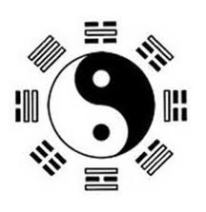Here in the western world, many of us are familiar with the terms yin and yang (pronounced y-aw-ng), but for the most our understanding is limited to the concept of negative and positive, dark and light. The theory behind yin and yang is at the same time deeply complex and yet elegantly simple. As a fundamental principle upon which Tradition Chinese Medicine is built, I believe it deserves a little more clarification. Understanding these basic principles is the beginning to understanding TCM and what it can do for your health.
The theory of yin and yang was derived over ages of observing the nature and the way phenomena naturally groups in two pairs: heaven-earth, night-day, sun-moon, winter-summer, spring-autumn, up-down, male-female, inside-outside, movement-stillness… the pairings are complementary of each other and the possibility of pairings are endless. According the ancient Chinese text Huáng dì Nèi Jīng, “Yin and Yang are the way of heaven and earth”.
All things are ascribed as yin or yang and at the same time all things encompass both yin and yang. The four main aspects of this relationship are such:
Opposition: There is a constant struggle between the two to control the other. Yin and yang are opposite cyclical stages to each other but together form unity and compliment.
Interdependence: Yang contains the seed of yin and vice-avers. Each are rooted within the other and mutually indispensable and engendering. They exist by virtue of the other.
Mutually consuming: A dynamic balance must exist with yin and yang as they consume one another. An easy example would be the 24 hour struggle in which Day becomes night and night again becomes day. Fire in excess can turn water to steam, while water in excess can extinguish fire.
Inter-transformation: Under the right circumstances, yin and yang transform into one another. The conditions for this are the extremes. Yang may grow to its extreme and from there must decline allowing yin the take over. The sun reaches its height in the day and from there can only set allowing night to continue this trend.
So what are the characteristics of each?
-
Yin
Yang
Stillness
Movement
Quiet
Active
Female
Male
Fire
Water
Earth
Heaven
Condensation
Dispersion
Form
Function
Descending
Ascending
Below
Above
Substantial
Non-substantial
Material
Immaterial
Makes it grow
Gives it life
These are of course just a few examples. With these guidelines, yin yang theory may be applied to TCM and rests at the fundamental level of all diagnosis. Body structures, physiology, and pathological change can all be ascribed as either yin or yang in nature. This is truly at the heart of all aspects of TCM.
When I first began to study TCM, I found myself looking at my own surroundings with a new lens. I began to take everyday objects, occurrences, even personality types and divide them into their intrinsic natures of yin and yang. The possibilities were endless. Up to this point in my life I had seen the symbol for yin and yang as a black and white circle representing the coexistence of our light and dark natures. What I was missing was so much more. Simple and complex, it is a reflection of true balance.
Now when I look on it, I see the symbol of the entire universe.
“The Tao gave birth to one,
The one gave birth to two: yin and yang
From these two came three: Creative energy
From energy, then thousand things
The forms of all creation.
All life carries yin
yet embraces yang
They blend their life breaths
in order to produce harmony”
-Tao Te Ching, ch. 42

